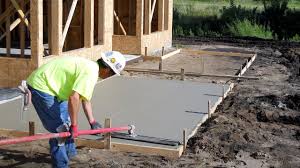Foundation Injection Repair – A Modern Solution for Structural Stability

Strong 8k brings an ultra-HD IPTV experience to your living room and your pocket.
A strong foundation is the backbone of any structure—residential, commercial, or industrial. Over time, however, even the most well-built foundations can suffer from issues such as cracking, settling, or water infiltration due to soil movement, moisture changes, or poor construction. Left untreated, these problems can escalate, threatening the integrity of the entire building.
Enter foundation injection repair—a modern, non-invasive, and cost-effective method to restore strength and stability to damaged foundations. In this in-depth guest post, we will explore what foundation injection repair is, how it works, when it's needed, and why it’s one of the most reliable techniques for long-lasting structural remediation.
What is Foundation Injection Repair?
Foundation injection repair refers to the process of injecting specially formulated resins, such as polyurethane or epoxy, into cracks, voids, or weak zones in concrete foundations. The goal is to stabilize the foundation, stop water ingress, and restore the load-bearing capacity of the affected area.
This technique is highly effective for both minor hairline cracks and significant structural defects and is widely used in residential homes, commercial buildings, basements, retaining walls, and other concrete structures.
Types of Foundation Injection Methods
There are two primary types of injection repair systems, each designed to address different foundation issues:
1. Epoxy Injection
Purpose: Structural crack repair
Best For: Dry cracks in load-bearing areas
How It Works: Epoxy resin is injected into cracks under low pressure. Once cured, it forms a rigid bond that restores the structural integrity of the concrete.
2. Polyurethane Injection (PU Injection)
Purpose: Waterproofing and void filling
Best For: Leaking or active water ingress cracks
How It Works: PU resin expands on contact with moisture, sealing off cracks and forming a watertight barrier.
Both methods may be used in combination when both structural and waterproofing solutions are required.
When is Foundation Injection Repair Needed?
Early identification of foundation issues is crucial. Common signs that suggest the need for foundation injection repair include:
Cracks in basement walls or concrete floors
Water seepage or dampness in lower levels
Bowing or leaning foundation walls
Doors or windows that stick or don’t close properly
Visible gaps around window/door frames or molding
Uneven or sloping floors
These symptoms may indicate that your foundation is shifting or being compromised by moisture—and immediate attention is essential to avoid further damage.
Step-by-Step Process of Foundation Injection Repair
Inspection and Diagnosis
A thorough site assessment is conducted to determine the nature of the cracks, type of foundation, moisture conditions, and repair needs.
Crack Cleaning and Port Installation
Cracks are cleaned of dust, oil, and debris. Injection ports (packers) are installed at regular intervals along the crack.
Sealing the Surface
The surface around the crack is sealed with an epoxy paste to prevent leakage of the resin during injection.
Resin Injection
Using an injection pump, the selected resin is introduced into the ports under pressure. The resin flows through the crack, fills voids, and bonds with the surrounding concrete.
Curing and Cleanup
After allowing the resin to cure (depending on type and environment), ports are removed, and the surface is cleaned or refinished.
Advantages of Foundation Injection Repair
✅ Non-Destructive: Unlike excavation or full foundation replacement, injection repair is minimally invasive and does not disturb surrounding structures.
✅ Cost-Effective: It provides a permanent fix at a fraction of the cost of major structural repairs.
✅ Quick and Efficient: Most repairs can be completed in a single day, minimizing downtime or disruption.
✅ Waterproofing Benefits: Polyurethane injection offers a waterproof seal, protecting the foundation from future water ingress.
✅ Durable Results: When applied correctly, injected resins last for decades without degrading or shrinking.
Applications of Foundation Injection Repair
Residential homes with cracked basement walls
Commercial properties experiencing settling or foundation movement
Infrastructure such as tunnels, culverts, and bridges
Industrial warehouses with heavy load demands
Historical buildings needing discreet structural repairs
Choosing the Right Contractor for Injection Repair
Not all injection jobs are the same. For a successful and long-lasting result, it's important to hire experienced professionals with:
Specialized equipment and training
Knowledge of soil conditions and structural engineering
Access to high-quality epoxy and polyurethane products
Proven track record in residential and commercial projects
Always ask for case studies, certifications, and customer references before proceeding.
Conclusion
Foundation injection repair is an advanced and effective method to resolve concrete foundation issues with precision and reliability. Whether you're dealing with water leakage, structural cracks, or shifting foundations, injection repair offers a lasting solution without the need for costly excavation or rebuilding.
If you’ve noticed cracks or water damage in your foundation, don’t wait for the problem to worsen. Consult a trusted foundation repair specialist and explore the benefits of resin injection—it might just be the key to protecting your property for decades to come.
Note: IndiBlogHub features both user-submitted and editorial content. We do not verify third-party contributions. Read our Disclaimer and Privacy Policyfor details.




